The global paper wrap market is valued at USD 4.8 billion in 2025 and is slated to reach USD 8.7 billion by 2035, recording an absolute increase of USD 3.9 billion over the forecast period. As per Future Market Insights, valued for advanced intelligence on biopolymer and barrier material adoption trends, this translates into a total growth of 81.3%, with the market forecast to expand at a CAGR of 6.1% between 2025 and 2035. The market size is expected to grow by nearly 1.81X during the same period, supported by increasing demand for biodegradable packaging alternatives in food service industries, growing adoption of eco-friendly wrapping solutions in retail operations, and rising preference for recyclable packaging materials across e-commerce logistics and quick-service restaurant applications.
Between 2025 and 2030, the paper wrap market is projected to expand from USD 4.8 billion to USD 6.5 billion, resulting in a value increase of USD 1.7 billion, which represents 43.6% of the total forecast growth for the decade. This phase of development will be shaped by increasing food delivery services requiring grease-resistant wrapping solutions, rising adoption of custom-printed paper wraps for brand visibility, and growing demand for paper wraps with enhanced moisture barrier properties and food safety compliance capabilities. Food service operators are expanding their paper wrap sourcing capabilities to address the growing demand for sandwich packaging, burger wraps, and quick-service meal applications.
Manufacturing operations encounter varying regulatory approaches across different markets, with European frameworks emphasizing circular economy principles while North American regulations focus on state-level plastic reduction initiatives. Several countries including France, Italy, and Germany have implemented extended producer responsibility programs requiring packaging manufacturers to demonstrate recyclability and contribute to waste management systems. China's upgraded plastic restrictions mandate 30% reduction in packaging waste while promoting recyclable material usage in food service applications.
Food service applications represent the dominant market segment where paper wraps provide essential barrier properties for bakery products, sandwiches, and fast-food packaging while complying with increasing restrictions on plastic alternatives. Restaurant operations and commercial kitchens increasingly specify grease-resistant paper wraps that maintain food safety standards without relying on plastic coatings or PFAS treatments. Quick-service restaurants value paper wraps for their printability, customization capabilities, and alignment with consumer expectations for sustainable packaging practices.
Technological advancement in barrier coatings, printing technologies, and sustainable material formulations creates opportunities for performance enhancement while maintaining cost competitiveness against plastic alternatives. Water-based barrier treatments, plant-based coatings, and biodegradable films enable paper wrap manufacturers to achieve enhanced grease resistance and moisture protection without relying on traditional plastic laminations or PFAS treatments. Digital printing technologies support mass customization, shorter production runs, and rapid design changes that appeal to brands seeking differentiated packaging solutions.
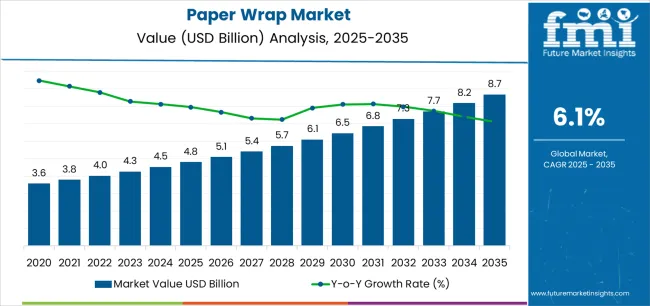
| Metric | Value |
|---|---|
| Estimated Value in (2025E) | USD 4.8 billion |
| Forecast Value in (2035F) | USD 8.7 billion |
| Forecast CAGR (2025 to 2035) | 6.1% |
The food packaging market is the largest contributor, accounting for about 35-40%. Paper wraps are extensively used in the packaging of food items, particularly for sandwiches, bakery products, and fast food, offering a lightweight and cost-effective solution for wrapping and serving. The growing preference for grab-and-go meals, take-out options, and convenient food packaging is driving the demand for paper wraps in foodservice applications. The retail packaging market adds approximately 25-30%, with paper wraps being used for wrapping gift items, clothing, and other retail goods. Their customizability and eco-friendly appeal make them popular for promotional and seasonal packaging in retail.
The eco-friendly packaging market contributes around 15-20%, as paper wraps are considered an environmentally conscious alternative to plastic wraps, with increasing consumer preference for recyclable and biodegradable options. The consumer goods packaging market provides about 10-12%, where paper wraps are used for packaging household products, cosmetics, and smaller consumer goods, ensuring easy handling and efficient transport. The industrial packaging market contributes about 8-10%, as paper wraps are used for protective packaging of smaller industrial items, components, and fragile goods during transit.
Market expansion is being supported by the increasing global demand for environmentally responsible packaging solutions and the corresponding need for wrapping materials that can provide effective food protection and grease resistance while enabling brand customization and meeting regulatory requirements across various food service and retail distribution applications. Modern restaurant operations and food retailers are increasingly focused on implementing packaging solutions that can maintain product freshness, prevent oil migration, and provide consistent performance throughout complex delivery networks. Paper wrap packaging's proven ability to deliver exceptional printability, enable brand differentiation through design, and support food safety compliance make them essential packaging formats for contemporary quick-service restaurants and specialty food operations.
The growing emphasis on plastic reduction initiatives and waste minimization is driving demand for paper wraps that can support recyclability requirements, improve environmental credentials, and enable fiber-based packaging formats. Operators' preference for wraps that combine effective food containment with aesthetic appeal and processing efficiency is creating opportunities for innovative paper wrap implementations. The rising influence of online food delivery platforms and grab-and-go retail formats is also contributing to increased demand for paper wraps that can provide grease resistance, moisture protection, and distinctive branding across diverse product categories.
The paper wrap market is poised for rapid growth and transformation. As industries across food service, retail bakeries, catering operations, and e-commerce fulfillment seek wrapping materials that deliver exceptional grease resistance, printability, and environmental compatibility, paper wraps are gaining prominence not just as functional packaging but as strategic enablers of brand visibility and consumer engagement.
Rising quick-service restaurant expansion in developing markets and expanding food delivery services globally amplify demand, while manufacturers are leveraging innovations in barrier coating technologies, digital printing capabilities, and advanced fiber formulations.
Pathways like compostable coating systems, premium printing capabilities, and application-specific basis weight optimization promise strong margin uplift, especially in high-value segments. Geographic expansion and vertical integration will capture volume, particularly where local manufacturing capabilities and food service industry proximity are critical. Regulatory pressures around plastic reduction mandates, food contact material standards, single-use plastic bans, and packaging waste regulations give structural support.
The market is segmented by basis weight, coating type, application, end-use industry, printing format, and region. By basis weight, the market is divided into 30-40 GSM, 40-50 GSM, 50-60 GSM, and above 60 GSM. By coating type, it covers wax-coated, poly-coated, uncoated, and others. By application, it includes food wrapping, gift wrapping, protective packaging, and others. By end-use industry, it is categorized into food service (quick-service restaurants, casual dining), retail (bakeries, delicatessens), catering services, e-commerce, and others. By printing format, it covers printed and unprinted. Regionally, the market is divided into North America, Europe, East Asia, South Asia & Pacific, Latin America, and the Middle East & Africa.
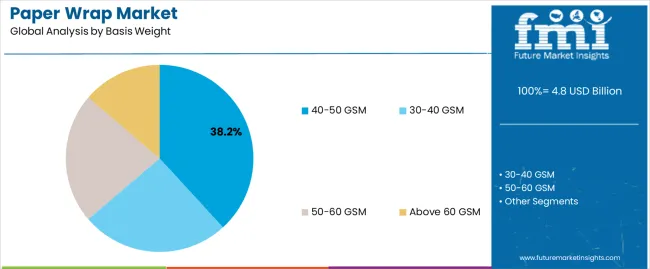
The 40-50 GSM segment is projected to account for 38.2% of the paper wrap market in 2025, reaffirming its position as the leading basis weight category. Food service operators and restaurant chains increasingly utilize 40-50 GSM paper wraps for their optimal balance between strength, grease resistance, and cost efficiency in sandwich wrapping, burger packaging, and hot food applications. The 40-50 GSM wrap technology's established industry acceptance and consistent folding performance directly address the operational requirements for reliable food containment in high-volume quick-service environments.
This basis weight segment forms the foundation of modern food service packaging operations, as it represents the specification with the greatest market penetration and established demand across multiple restaurant formats and global markets. Manufacturer investments in enhanced coating formulations and improved fiber selection continue to strengthen adoption among quick-service restaurants and catering operations. With operators prioritizing food safety and operational efficiency, 40-50 GSM paper wraps align with both performance requirements and handling compatibility objectives, making them the central component of comprehensive packaging strategies.
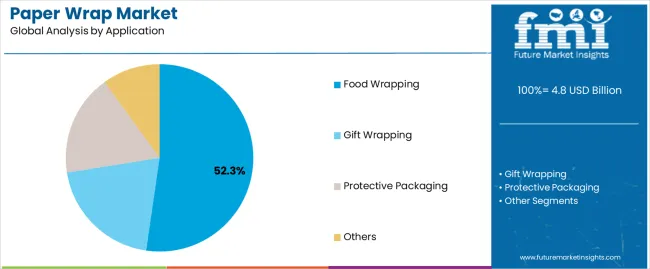
Food wrapping applications are projected to represent 52.3% of paper wrap demand in 2025, underscoring their critical role as the primary industrial consumers of paper wrapping materials for sandwich packaging, burger wraps, hot food containment, and quick-service meal distribution. Food service operators prefer paper wraps for their exceptional grease barrier capabilities, effective moisture management, and ability to maintain product integrity while ensuring food safety with compliant packaging. Positioned as essential wrapping formats for modern restaurant and food retail operations, paper wraps offer both functional advantages and brand communication benefits.
The segment is supported by continuous innovation in barrier coating technologies and the growing availability of specialized printing capabilities that enable brand messaging with enhanced visual appeal and marketing effectiveness. Food service operators are investing in automated wrapping systems to support large-volume paper wrap utilization and operational efficiency. As online food delivery becomes more prevalent and grab-and-go consumption increases, food wrapping applications will continue to dominate the end-use market while supporting advanced printing techniques and custom branding strategies.
The paper wrap market is advancing rapidly due to increasing demand for plastic-free packaging in food service industries and growing adoption of biodegradable wrapping solutions that provide effective product protection and grease resistance while enabling brand visibility across diverse food service and retail distribution applications. The market faces challenges, including price competition from plastic film alternatives, moisture sensitivity limitations, and the need for specialized coating equipment investments. Innovation in barrier coating technologies and advanced printing capabilities continues to influence product development and market expansion patterns.
The growing adoption of digital printing systems, flexographic color processes, and sophisticated design reproduction techniques is enabling manufacturers to produce paper wraps with superior graphic quality, enhanced brand presentation, and short-run production capabilities. Advanced printing systems provide improved visual impact while allowing more efficient custom batch production and consistent quality across various food service applications and restaurant chains. Manufacturers are increasingly recognizing the competitive advantages of premium printing capabilities for brand differentiation and marketing effectiveness.
Modern paper wrap producers are incorporating plant-based barrier coatings, compostable adhesive systems, and certification-ready formulations to enhance end-of-life disposal options, enable composting infrastructure compatibility, and deliver value-added environmental solutions to food service brands and retail customers. These technologies improve environmental performance while enabling new operational capabilities, including waste diversion, composting programs, and circular economy participation. Advanced coating integration also allows manufacturers to support brand owners and regulatory compliance beyond traditional packaging approaches.
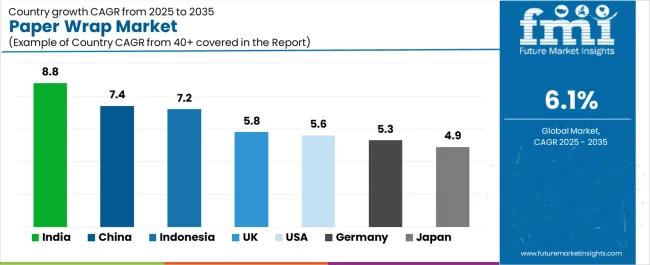
| Country | CAGR (2025-2035) |
|---|---|
| India | 8.8% |
| China | 7.4% |
| USA | 5.6% |
| Indonesia | 7.2% |
| Germany | 5.3% |
| Japan | 4.9% |
| United Kingdom | 5.8% |
The paper wrap market is experiencing strong growth globally, with India leading at an 8.8% CAGR through 2035, driven by the expanding food service industry, growing quick-service restaurant penetration, and significant investment in modern retail infrastructure development. China follows at 7.4%, supported by rapid urbanization growth, increasing takeaway food consumption, and growing e-commerce food delivery demand. The USA shows growth at 5.6%, emphasizing plastic reduction initiatives and environmentally conscious packaging development. Indonesia records 7.2%, focusing on food service modernization and growing urban food consumption. Germany demonstrates 5.3% growth, prioritizing packaging innovation standards and advanced coating technology excellence. Japan exhibits 4.9% growth, emphasizing food safety standards and premium packaging quality. The United Kingdom shows 5.8% growth, supported by plastic ban implementation and food service packaging innovation.
The report covers an in-depth analysis of 40+ countries, with the top-performing countries highlighted below.
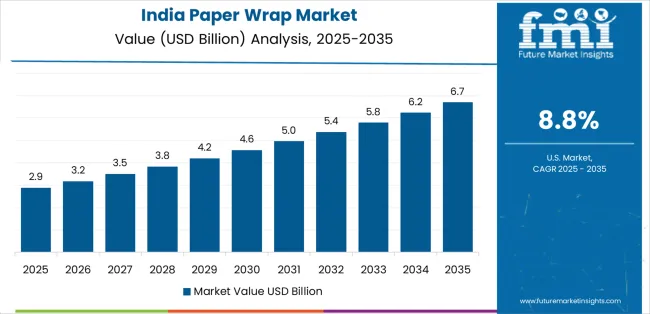
Revenue from paper wraps in India is projected to exhibit exceptional growth with a CAGR of 8.8% through 2035, driven by expanding quick-service restaurant chains and rapidly growing food delivery platforms supported by urbanization trends promoting modern food consumption patterns. The country's strong position in organized retail development and increasing investment in food service infrastructure are creating substantial demand for paper wrap solutions. Major restaurant chains and cloud kitchen operators are establishing comprehensive packaging sourcing capabilities to serve both dine-in operations and delivery service markets.
Demand for paper wraps in China is expanding at a CAGR of 7.4%, supported by the country's massive food delivery market, expanding restaurant modernization activities, and increasing adoption of branded packaging solutions. The country's government initiatives promoting waste reduction and growing middle-class food consumption patterns are driving requirements for advanced wrapping capabilities. International brands and domestic manufacturers are establishing extensive production and distribution capabilities to address the growing demand for paper wrap products.
Revenue from paper wraps in the USA is growing at a CAGR of 5.6%, supported by the country's strong plastic reduction movement, robust emphasis on compostable packaging alternatives, and widespread demand for high-performance wraps in burger and sandwich applications. The nation's mature food service sector and environmentally focused operations are driving sophisticated coated paper wrap systems throughout the supply chain. Leading manufacturers and technology providers are investing extensively in coating equipment and printing capabilities to serve both domestic and international markets.
Demand for paper wraps in Indonesia is anticipated to expand at a CAGR of 7.2%, driven by the country's rapidly expanding quick-service restaurant sector, growing food delivery platforms, and increasing investment in modern retail formats. Indonesia's large urban population and commitment to food service infrastructure development are supporting demand for paper wrap solutions across multiple consumption segments. Manufacturers are establishing comprehensive production capabilities to serve the growing domestic market and regional export opportunities.
Revenue from paper wraps in Germany is growing at a CAGR of 5.3%, supported by the country's advanced packaging technology leadership, sophisticated manufacturing capabilities, and strategic focus on high-quality wrap production. Germany's technical excellence and innovation focus are driving demand for paper wraps in bakery packaging, quick-service restaurants, and specialty food applications. Manufacturers are investing in comprehensive automation capabilities to serve both domestic food service operators and international specialty markets.
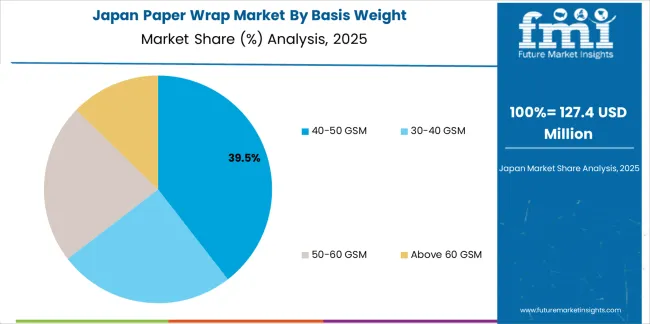
Demand for paper wraps in Japan is forecasted to grow at a CAGR of 4.9%, driven by the country's expertise in packaging innovation, emphasis on food safety excellence, and strong position in convenience store operations and bakery packaging. Japan's established packaging technology capabilities and commitment to quality are supporting investment in advanced production technologies throughout major manufacturing centers. Industry leaders are establishing comprehensive quality systems to serve domestic food service operators and retail businesses.
Revenue from paper wraps in the United Kingdom is expanding at a CAGR of 5.8%, supported by the country's aggressive plastic reduction legislation, growing quick-service restaurant sector, and strategic position in European food service markets. The UK's environmental policy leadership and integrated food service infrastructure are driving demand for high-performance paper wraps in sandwich shops, coffee chains, and takeaway operations. Leading manufacturers are investing in specialized capabilities to serve the stringent requirements of environmentally conscious brands and regulatory frameworks.
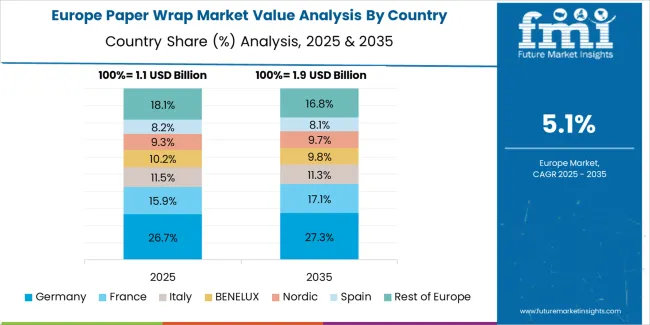
The paper wrap market in Europe is projected to grow from USD 1.3 billion in 2025 to USD 2.4 billion by 2035, registering a CAGR of 6.4% over the forecast period. Germany is expected to maintain its leadership position with a 26.5% market share in 2025, declining slightly to 26.0% by 2035, supported by its strong packaging technology base, advanced coating production capabilities, and comprehensive food service and bakery sector serving diverse paper wrap applications across Europe.
The United Kingdom follows with a 24.0% share in 2025, projected to reach 24.5% by 2035, driven by robust demand for paper wraps in sandwich shop operations, coffee chain packaging, and quick-service restaurant applications, combined with established plastic reduction legislation and environmentally focused food service infrastructure. France holds a 18.5% share in 2025, expected to reach 19.0% by 2035, supported by strong bakery traditions and growing food service modernization. Italy commands a 13.5% share in 2025, projected to reach 14.0% by 2035, while Spain accounts for 8.5% in 2025, expected to reach 9.0% by 2035. Poland maintains a 4.5% share in 2025, growing to 4.8% by 2035. The Rest of Europe region, including Nordic countries, Eastern Europe, Belgium, Netherlands, and other nations, is anticipated to maintain momentum, with its collective share moving from 4.5% to 2.7% by 2035, attributed to increasing food service operations in Eastern Europe and growing environmental packaging adoption in Nordic countries implementing advanced wrapping programs.
The Paper Wrap Market is expanding quickly as brands shift toward sustainable, recyclable, and plastic-free packaging solutions. Growing regulatory pressure to reduce single-use plastics, alongside rising consumer preference for eco-friendly packaging, is accelerating the adoption of paper wraps in food, retail, e-commerce, and specialty goods. Kraft paper, coated paper, and barrier-enhanced wraps are becoming mainstream as converters improve strength, printability, and moisture resistance without relying on plastics.
International Paper Company, WestRock Company, and Smurfit Kappa Group anchor the global landscape with large-scale fiber production, advanced paper converting technologies, and customizable paper wrap formats for consumer goods and food packaging. Mondi Group and Georgia-Pacific LLC continue to push innovation in recyclable barrier coatings, enabling paper wraps to replace plastics in applications requiring grease, moisture, or oxygen resistance.
Specialty producers such as Ahlstrom-Munksjö, Delfortgroup AG, and Nordic Paper AB focus on high-performance wrapping papers used in bakery, confectionery, quick-service food, and industrial packaging. Their strength lies in lightweight yet durable papers with natural barrier properties and excellent print quality. Mitsubishi HiTec Paper Europe GmbH brings expertise in coated papers, supplying premium wraps that balance shelf appeal with functional protection.
| Items | Values |
|---|---|
| Quantitative Units (2025) | USD 4.8 billion |
| Basis Weight | 30-40 GSM, 40-50 GSM, 50-60 GSM, Above 60 GSM |
| Coating Type | Wax-Coated, Poly-Coated, Uncoated, Others |
| Application | Food Wrapping, Gift Wrapping, Protective Packaging, Others |
| End-Use Industry | Food Service (QSR, Casual Dining), Retail (Bakeries, Delis), Catering Services, E-Commerce, Others |
| Printing Format | Printed, Unprinted |
| Regions Covered | North America, Europe, East Asia, South Asia & Pacific, Latin America, Middle East & Africa |
| Countries Covered | United States, Canada, United Kingdom, Germany, France, China, Japan, South Korea, India, Indonesia, Australia and 40+ countries |
| Key Companies Profiled | International Paper Company, WestRock Company, Mondi Group, Smurfit Kappa Group, Georgia-Pacific LLC, Sealed Air Corporation, Ahlstrom-Munksjö, Delfortgroup AG, Nordic Paper AB, Mitsubishi HiTec Paper Europe GmbH |
| Additional Attributes | Dollar sales by basis weight and application category, regional demand trends, competitive landscape, technological advancements in coating systems, fiber formulation development, printing equipment innovation, and supply chain integration |
The global paper wrap market is estimated to be valued at USD 4.8 billion in 2025.
The market size for the paper wrap market is projected to reach USD 8.7 billion by 2035.
The paper wrap market is expected to grow at a 6.1% CAGR between 2025 and 2035.
The key product types in paper wrap market are 40-50 gsm , 30-40 gsm, 50-60 gsm and above 60 gsm.
In terms of application, food wrapping segment to command 52.3% share in the paper wrap market in 2025.






Our Research Products

The "Full Research Suite" delivers actionable market intel, deep dives on markets or technologies, so clients act faster, cut risk, and unlock growth.

The Leaderboard benchmarks and ranks top vendors, classifying them as Established Leaders, Leading Challengers, or Disruptors & Challengers.

Locates where complements amplify value and substitutes erode it, forecasting net impact by horizon

We deliver granular, decision-grade intel: market sizing, 5-year forecasts, pricing, adoption, usage, revenue, and operational KPIs—plus competitor tracking, regulation, and value chains—across 60 countries broadly.

Spot the shifts before they hit your P&L. We track inflection points, adoption curves, pricing moves, and ecosystem plays to show where demand is heading, why it is changing, and what to do next across high-growth markets and disruptive tech

Real-time reads of user behavior. We track shifting priorities, perceptions of today’s and next-gen services, and provider experience, then pace how fast tech moves from trial to adoption, blending buyer, consumer, and channel inputs with social signals (#WhySwitch, #UX).

Partner with our analyst team to build a custom report designed around your business priorities. From analysing market trends to assessing competitors or crafting bespoke datasets, we tailor insights to your needs.
Supplier Intelligence
Discovery & Profiling
Capacity & Footprint
Performance & Risk
Compliance & Governance
Commercial Readiness
Who Supplies Whom
Scorecards & Shortlists
Playbooks & Docs
Category Intelligence
Definition & Scope
Demand & Use Cases
Cost Drivers
Market Structure
Supply Chain Map
Trade & Policy
Operating Norms
Deliverables
Buyer Intelligence
Account Basics
Spend & Scope
Procurement Model
Vendor Requirements
Terms & Policies
Entry Strategy
Pain Points & Triggers
Outputs
Pricing Analysis
Benchmarks
Trends
Should-Cost
Indexation
Landed Cost
Commercial Terms
Deliverables
Brand Analysis
Positioning & Value Prop
Share & Presence
Customer Evidence
Go-to-Market
Digital & Reputation
Compliance & Trust
KPIs & Gaps
Outputs
Full Research Suite comprises of:
Market outlook & trends analysis
Interviews & case studies
Strategic recommendations
Vendor profiles & capabilities analysis
5-year forecasts
8 regions and 60+ country-level data splits
Market segment data splits
12 months of continuous data updates
DELIVERED AS:
PDF EXCEL ONLINE
Market Share Breakdown of Paper Wrap Market
Paper Bubble Wrap Market Trends - Demand, Innovations & Growth 2025 to 2035
Global Burger Wrap Paper Market Analysis – Growth & Forecast 2024-2034
Protective Wrapping Paper Market Size and Share Forecast Outlook 2025 to 2035
Wrapping Machines for Handkerchiefs Market Size and Share Forecast Outlook 2025 to 2035
Paperboard Partition Market Size and Share Forecast Outlook 2025 to 2035
Paper Box Market Size and Share Forecast Outlook 2025 to 2035
Wrapping Tissues Market Size and Share Forecast Outlook 2025 to 2035
Paper Edge Protector Market Size and Share Forecast Outlook 2025 to 2035
Paper Cup Lids Market Size and Share Forecast Outlook 2025 to 2035
Paper Pallet Market Size and Share Forecast Outlook 2025 to 2035
Paper and Paperboard Packaging Market Forecast and Outlook 2025 to 2035
Wrap Around Cartoners Market Size and Share Forecast Outlook 2025 to 2035
Paper Cups Market Size and Share Forecast Outlook 2025 to 2035
Paper Core Market Size and Share Forecast Outlook 2025 to 2035
Paper Bags Market Size and Share Forecast Outlook 2025 to 2035
Paper Processing Resins Market Size and Share Forecast Outlook 2025 to 2035
Paper Tester Market Size and Share Forecast Outlook 2025 to 2035
Paper Napkin Converting Lines Market Size and Share Forecast Outlook 2025 to 2035
Paper Packaging Tapes Market Size and Share Forecast Outlook 2025 to 2035

Thank you!
You will receive an email from our Business Development Manager. Please be sure to check your SPAM/JUNK folder too.
Chat With
MaRIA